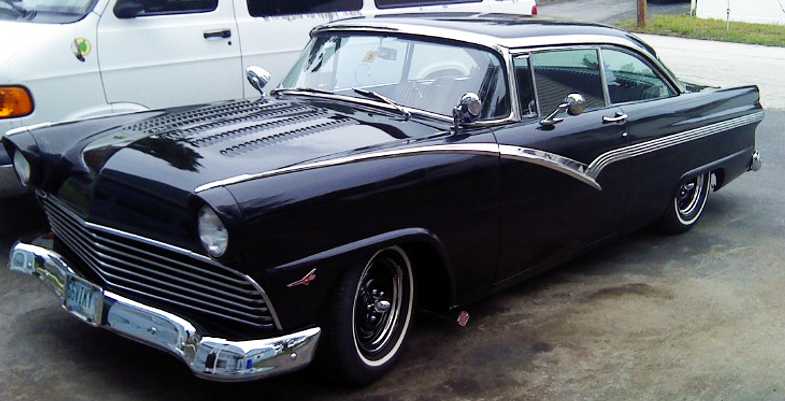|
Author
|
Message
|
|
YBLOCKMERC
|
|
|
Group: Forum Members
Last Active: 8 Months Ago
Posts: 194,
Visits: 20.6K
|
The original specification for my '54 Merc convertible called for 24#/front and 22#/rear. I now have comparably sized radials on the car. Should I use the same specification? If not, what would the recommended pressure(s) be? I'm preparing to go on a 600 mile road trip, highway miles, in 70-90* temps.
Marc
|
|
|
|
|
Dobie Gillis
|
|
|
Group: Forum Members
Last Active: 11 Years Ago
Posts: 64,
Visits: 1.7K
|
YBLOCKMERC (8/21/2013)
The original specification for my '54 Merc convertible called for 24#/front and 22#/rear. I now have comparably sized radials on the car. Should I use the same specification? If not, what would the recommended pressure(s) be?
I'm preparing to go on a 600 mile road trip, highway miles, in 70-90* temps.I would start with the tire manufacturer's cold inflation spec and see how that works, then adjust as needed. I would not go below the recommended spec. I run 10% higher than the spec on my daily driver for a bit better road feel and less rolling resistance. My last set lasted 80K miles +.
|
|
|
|
|
STX
|
|
|
Group: Forum Members
Last Active: 11 Years Ago
Posts: 31,
Visits: 214
|
On radials you need much higher tire pressure.
You will notice that the steering force (without power steering) will be very high if you use the recommended pressure in the manual.
I run my Coker radials at 40 psi or 2.8 bar and even more, no problems. I recommend you to do the same.
1955 Mercurys with and without power steering.
1955 Mercury
|
|
|
|
|
MoonShadow
|
|
|
Group: Forum Members
Last Active: Yesterday
Posts: 4.6K,
Visits: 38.5K
|
It seems common nowadays to see tires set at recommended pressure wearing on the outer edges. When I see this I advise folks to up their pressure a couple of pounds so the tire will ride flatter on the pavement. Chuck
Y's guys rule!
Looking for McCullouch VS57 brackets and parts. Also looking for 28 Chrysler series 72 parts. And early Hemi parts.
 
MoonShadow, 292 w/McCulloch, 28 Chrysler Roadster, 354 Hemi)
Manchester, New Hampshire
|
|
|
|
|
Talkwrench
|
|
|
Group: Forum Members
Last Active: 4 Years Ago
Posts: 898,
Visits: 23.2K
|
|
|
|
|
|
YBLOCKMERC
|
|
|
Group: Forum Members
Last Active: 8 Months Ago
Posts: 194,
Visits: 20.6K
|
Thanks for the feedback. I went to the D'Back tires website and they didn't make a specific recommendation but did mention 35 lb cold as a good starting point. That's what I'm going with. Can't wait to get on road with my Y. Going from the Seattle area to Lewiston, ID for a weekend with friends and a big annual car show & cruise. I made this run last year and the 292 was amazing!
Marc
|
|
|
|
|
lovefordgalaxie
|
|
|
Group: Forum Members
Last Active: 9 Years Ago
Posts: 269,
Visits: 1.0K
|
On the Galaxies that came with radials here, the tire size was 215R-15 and the inflation pressure recommended by Ford was 28 lbs on all four tires. They also recommended to add two extra pounds if going to keep sustained high speeds for an hour or more.
Now compare that with the specs for the bias ply tires: 24 lbs. The bias ply tire size was 7,75X15 or F70X15 as an option, both tires should use 24 lbs.
Go with 35, and if you see the tires are too hard, try 30, that's what I would do.
Túlio Lazzaroni "FORD", Florianópolis SC Brasil.
'74 Ford Galaxie 500 292 V8
'82 Ford Galaxie Landau 302 V8
'98 Chevrolet S10 4.3 V6
'01 Ford Focus 1.8 Zetec
|
|
|
|
|
STX
|
|
|
Group: Forum Members
Last Active: 11 Years Ago
Posts: 31,
Visits: 214
|
35 psi is good if you want a soft ride  . The feeling depends much on the quality of the road. . The feeling depends much on the quality of the road.
GM recommends 35 psi for my 1987 Buick Regal with P215R65-15, so a few psi more will not hurt.
40 years ago 28 psi was standard, but nowadays it is regarded low.
Nevertheless, it is for most circumstances better to have a little more pressure than less.
Better fuel consumption.
Less tire wear.
More even tire wear.
Easier to steer at low speeds.
Higher speed.
Less wear and forces on suspension and steering parts.
Better handling.
Less noise.
Cooler tire.
Can handle more load.
Less prone to explode due to delamination.
Many pros, but few cons.
You can always reduce the pressure if it feels too hard.
Have a nice trip!
1955 Mercury
|
|
|
|
|
Talkwrench
|
|
|
Group: Forum Members
Last Active: 4 Years Ago
Posts: 898,
Visits: 23.2K
|
|
|
|
|
|
speedpro56
|
|
|
Group: Forum Members
Last Active: Last Year
Posts: 1.3K,
Visits: 9.2K
|
All of my radials say max 44 psi so I run 40 for gas mileage and stability. When running 35 I seem to wear a little more on the edges than I like but not really all that bad so 35 should work and that may depend on the weight of the car. On my truck and van it's 80 psi but that's a different radial all together.
-Gary Burnette-
|
|
|
|